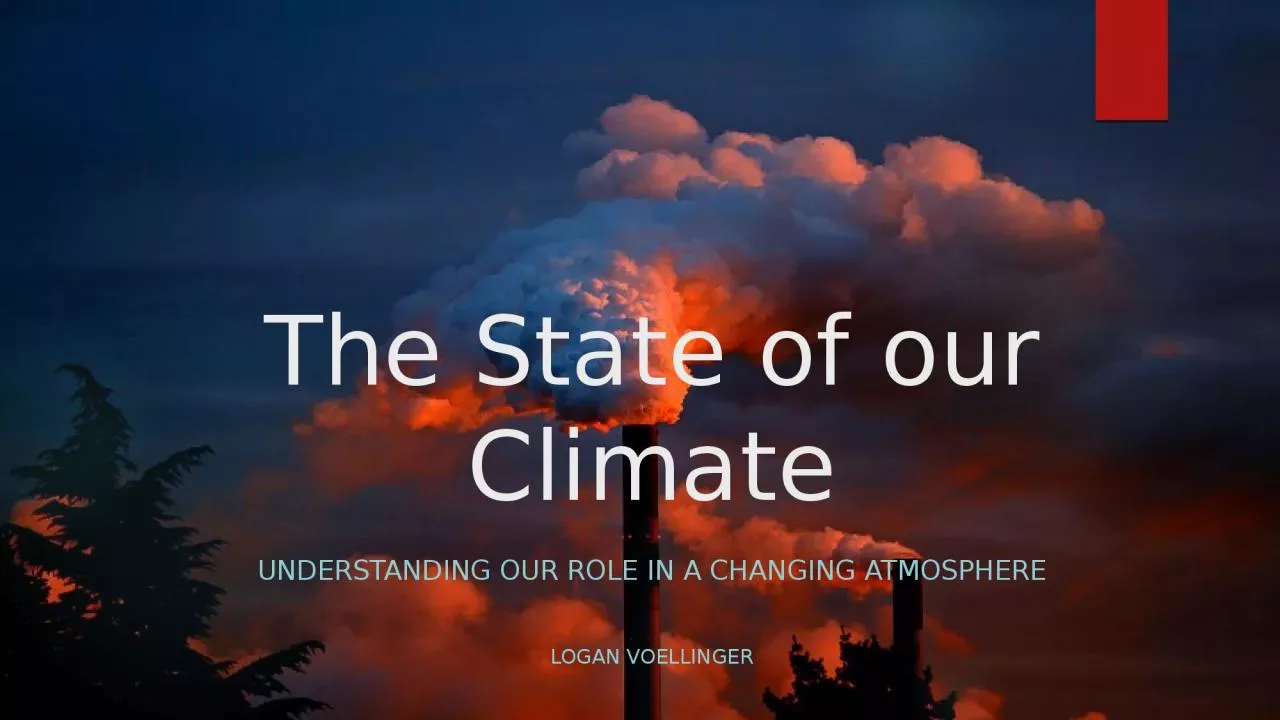

Understanding our role in a changing atmosphere Logan Voellinger The Carbon Cycle Carbon Sinks Carbon reservoirs that accumulate over time storing carbon outside of typical atmospheric carbon cycles ID: 1026637
Download Presentation The PPT/PDF document "The State of our Climate" is the property of its rightful owner. Permission is granted to download and print the materials on this web site for personal, non-commercial use only, and to display it on your personal computer provided you do not modify the materials and that you retain all copyright notices contained in the materials. By downloading content from our website, you accept the terms of this agreement.
1. The State of our ClimateUnderstanding our role in a changing atmosphereLogan Voellinger
2. The Carbon Cycle
3. Carbon SinksCarbon reservoirs that accumulate over time, storing carbon outside of typical atmospheric carbon cycles.Deep oceansSoils/rocksPlants & animals (while they’re alive)Fossils/non-decomposed organic matter (oil)Relatively inaccessible, and stay “locked away” until…FiresVolcanoesHumans dig them up and burn them
4. The Current Balance
5. Exactly How Much do we Emit?= 37.1 Billion tons (2018)(= 37,100,000,000,000 kg CO2)(= 715,075,000,000,000 ft3 CO2)
6. Atmospheric CO2 over the Yearsclimate.nasa.govGlobal Population:~750 millionGlobal Population:~8 billion
7. OK, there’s a lot more Carbon in the air.So What?Increased atmospheric Carbon => increased surface temperaturesGreenhouse Gases in the atmosphere block radiative heat lossMore frequent extreme weather events (droughts, floods, hurricanes, heat waves, fires)Rising sea levels due to melting glacial ice (ice that reflects the sun’s heat energy!)Ocean AcidificationpH decreases (acidifies) as it intakes CO2Drastically impacts corals and shellfishLoss of algae that provides ~90% of coral’s energy supply (bleaching) Water Problems, Food Problems, Ecosystem Problems“Climate refugees” due to water and food security issuesShifting agricultural zones/habitable zonesMass plant and animal migrations (and extinctions) due to ecosystem changes and loss
8.
9. Greenhouse Gases over the YearsMethaneWarming Potential = 86x CO2 equivalent (over 20 yrs)Methane lifespan: ~10yrs (then converts to CO2 and H2O, which are both greenhouse gases)Nitrous OxideWarming Potential = 298x CO2 equivalent (over 100 yrs)N20 lifespan: ~114 yrs
10. Methane on the Rise
11. More Humans means More Emissions
12. It’s Getting Hot in Here
13. It’s Getting Hot in Here
14. Ice is Melting (Faster and Faster)Land ice sheets in both Antarctica (left) and Greenland (right) have been losing mass since 2002. Both have seen an acceleration of ice mass loss since 2009.
15. We Can Have an ImpactOzone levels stabilized in the 1990s following the 1987 Montreal Protocol, and have started to recover. They are projected to reach pre-1980 levels before 2075Production of CFCs frozen at 1986 levels; countries agreed to reduce production by 50% by 1999(1976 report by the US National Academy of Sciences concluded that ozone was depleting)
16. EPA Clean Air ActBefore President Richard Nixon created the Environmental Protection Agency in 1970, water and air pollution weren't federally regulatedBetween 1971 and 1977, the EPA enlisted 100 photographers to document the conditions of the country and the environment with "The Documerica Project."
17. In New Orleans, toxic fumes spread over the streets, billowing out from Kaiser Aluminum Plant's smoke stack.
18. The George Washington Bridge going over the Hudson River, covered in thick smog. In 1965, a study by New York City Council found breathing New York's air had the same effect as smoking two packets of cigarettes a day.
19. A house in North Birmingham is barely visible in industrial smog coming from the North Birmingham Pipe Plant. It was the most polluted area of the city.
20. In Delaware, the city incinerator billows out smoke over the river. In 2016, a report released by New York University said 41 people living in Delaware still die because of air pollution every year.
21. In Bayonne, New Jersey, raw and partially digested sewage can be seen darkening the water.
22. Here, acid waste lightens the water. Acid waste was also dumped in the New York Bight, 15 miles off-shore. In 1974, more than 3 million tons were dumped in the Bight. It is estimated about 6 million gallons of coal were dumped into the New York Bight by the Edison Power Plant in Manhattan in the early 1970s.
23. In an illegal dump in New Orleans, garbage turned to sludge when a lake overflowed into it. In the 1970s, the EPA found 66 pollutants in the city's drinking water. And the city's water is known for its oily taste.
24. Common Anti-Climate Change ArgumentsNot all scientists agree in human-caused climate change!Over 98% of climate scientists agree humans are driving climate change(Just like 97% of scientists agree smoking causes cancer)The climate has always been changing since before there were humans!True, but… these cycles occur over hundreds of thousands of years, not decades.(“Smoking doesn’t cause cancer, people have always gotten cancer!”)Don’t forget: mass extinctions, ice ages, and inhospitably hot conditions have also occurredWhat about all these record cold temperatures and snowfalls? So much for Global Warming!More snowfall during winter storms is an expected effect of climate changeAverage global annual temperatures are still increasingCold, polar air is reaching further south than normal in the US and Europe (polar vortex)
25. What Can I Do?Cut the beef (and lamb) – Shop for food produced locally!Get your electricity from Green Sources/incentive programsReduce plastic consumption (refill a water bottle!)Don’t use fuel-inefficient vehicles (or airplanes)Be informed on the scienceAlmost everything is more complex than it seems
26. Referenceshttps://archive.epa.gov/epa/climate-change-science/causes-climate-change.htmlhttps://climate.nasa.gov/vital-signs/ice-sheets/https://www.epa.gov/ghgemissions/global-greenhouse-gas-emissions-datahttps://www.eia.gov/todayinenergy/detail.php?id=5810https://www.wri.org/blog/2019/04/6-pressing-questions-about-beef-and-climate-change-answeredhttps://www.epa.gov/history/historical-photos-and-images
27. Questions?
28. Where are the emissions coming from?Source: IPCC (2014)Approximately 20% offset by plant growth, soil sequestration, dead organic matter(2010 data)